An Examination of Psychosocial Development in Early Childhood (401005)
VerifiedAdded on 2022/10/31
|6
|1717
|345
Essay
AI Summary
This essay delves into the psychosocial development of children aged 2 to 5, also known as the preschool years. It explores key aspects such as physical, cognitive, emotional, social, and language development, with specific reference to Erikson's theory of psychosocial development, highlighting the stage of initiative vs. guilt. The essay analyzes a case study, using it to illustrate concepts like language acquisition, social interaction, and parental roles in fostering healthy development. It emphasizes the importance of parental involvement, including providing a supportive environment, encouraging social interaction, and addressing potential challenges like toilet training. The paper also references the importance of sleep, healthy eating habits, and limiting screen time for this age group, and stresses the need for parents to show love and affection and train them with important skills. The essay concludes by summarizing the core developmental milestones and challenges faced by children and their parents during this crucial period. The essay follows the assignment brief provided, adhering to the specified word count, formatting guidelines, and referencing requirements.
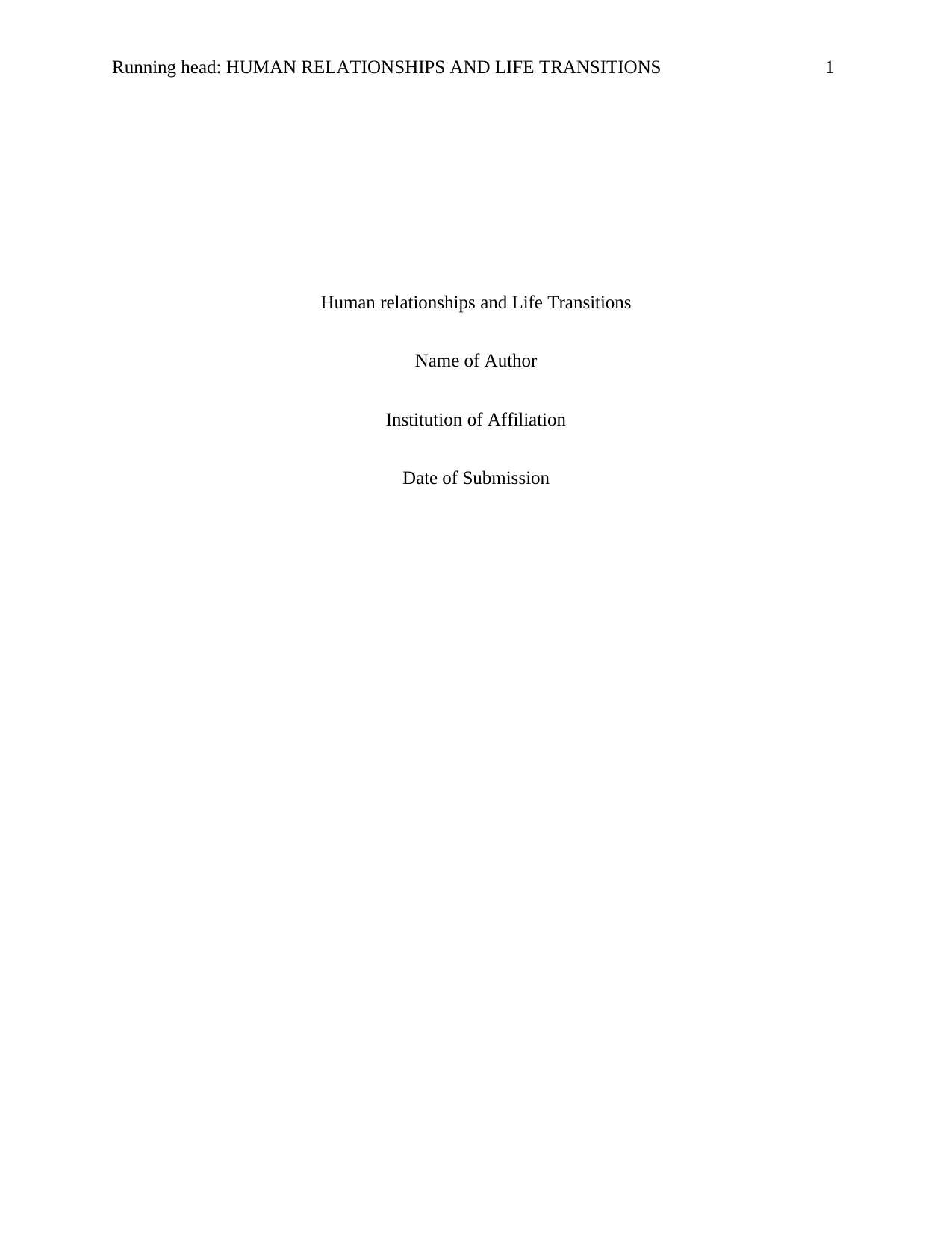
Running head: HUMAN RELATIONSHIPS AND LIFE TRANSITIONS 1
Human relationships and Life Transitions
Name of Author
Institution of Affiliation
Date of Submission
Human relationships and Life Transitions
Name of Author
Institution of Affiliation
Date of Submission
Paraphrase This Document
Need a fresh take? Get an instant paraphrase of this document with our AI Paraphraser
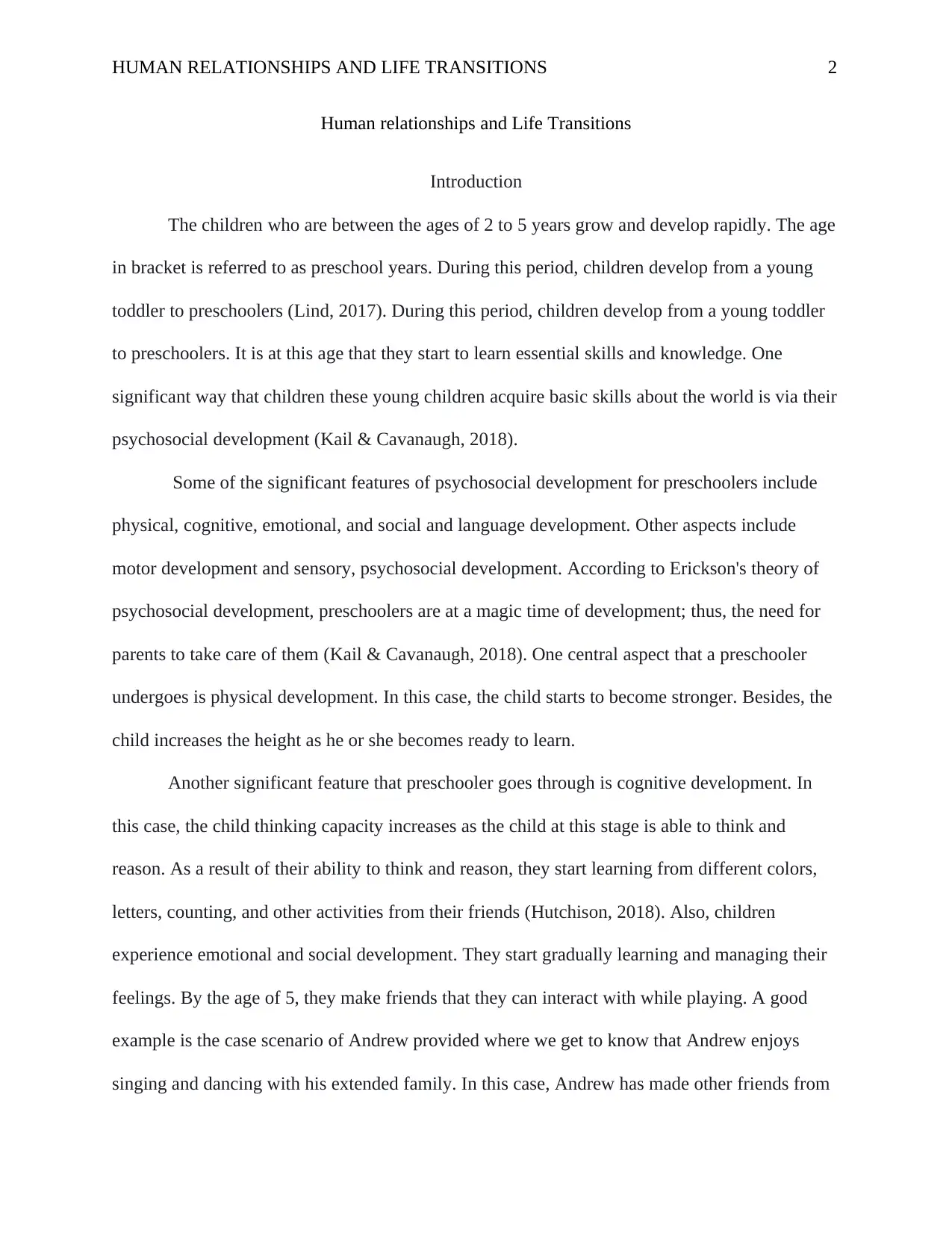
HUMAN RELATIONSHIPS AND LIFE TRANSITIONS 2
Human relationships and Life Transitions
Introduction
The children who are between the ages of 2 to 5 years grow and develop rapidly. The age
in bracket is referred to as preschool years. During this period, children develop from a young
toddler to preschoolers (Lind, 2017). During this period, children develop from a young toddler
to preschoolers. It is at this age that they start to learn essential skills and knowledge. One
significant way that children these young children acquire basic skills about the world is via their
psychosocial development (Kail & Cavanaugh, 2018).
Some of the significant features of psychosocial development for preschoolers include
physical, cognitive, emotional, and social and language development. Other aspects include
motor development and sensory, psychosocial development. According to Erickson's theory of
psychosocial development, preschoolers are at a magic time of development; thus, the need for
parents to take care of them (Kail & Cavanaugh, 2018). One central aspect that a preschooler
undergoes is physical development. In this case, the child starts to become stronger. Besides, the
child increases the height as he or she becomes ready to learn.
Another significant feature that preschooler goes through is cognitive development. In
this case, the child thinking capacity increases as the child at this stage is able to think and
reason. As a result of their ability to think and reason, they start learning from different colors,
letters, counting, and other activities from their friends (Hutchison, 2018). Also, children
experience emotional and social development. They start gradually learning and managing their
feelings. By the age of 5, they make friends that they can interact with while playing. A good
example is the case scenario of Andrew provided where we get to know that Andrew enjoys
singing and dancing with his extended family. In this case, Andrew has made other friends from
Human relationships and Life Transitions
Introduction
The children who are between the ages of 2 to 5 years grow and develop rapidly. The age
in bracket is referred to as preschool years. During this period, children develop from a young
toddler to preschoolers (Lind, 2017). During this period, children develop from a young toddler
to preschoolers. It is at this age that they start to learn essential skills and knowledge. One
significant way that children these young children acquire basic skills about the world is via their
psychosocial development (Kail & Cavanaugh, 2018).
Some of the significant features of psychosocial development for preschoolers include
physical, cognitive, emotional, and social and language development. Other aspects include
motor development and sensory, psychosocial development. According to Erickson's theory of
psychosocial development, preschoolers are at a magic time of development; thus, the need for
parents to take care of them (Kail & Cavanaugh, 2018). One central aspect that a preschooler
undergoes is physical development. In this case, the child starts to become stronger. Besides, the
child increases the height as he or she becomes ready to learn.
Another significant feature that preschooler goes through is cognitive development. In
this case, the child thinking capacity increases as the child at this stage is able to think and
reason. As a result of their ability to think and reason, they start learning from different colors,
letters, counting, and other activities from their friends (Hutchison, 2018). Also, children
experience emotional and social development. They start gradually learning and managing their
feelings. By the age of 5, they make friends that they can interact with while playing. A good
example is the case scenario of Andrew provided where we get to know that Andrew enjoys
singing and dancing with his extended family. In this case, Andrew has made other friends from
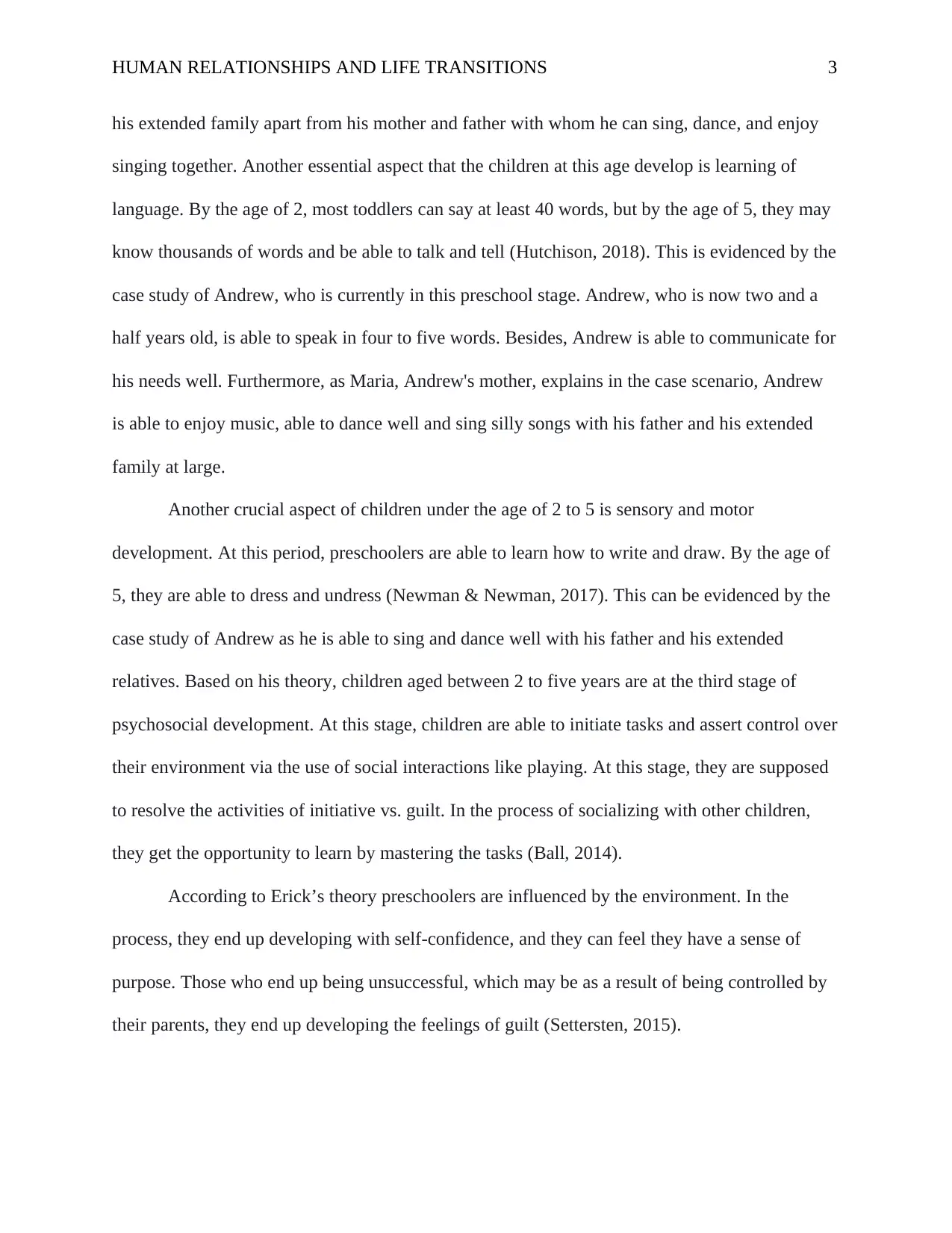
HUMAN RELATIONSHIPS AND LIFE TRANSITIONS 3
his extended family apart from his mother and father with whom he can sing, dance, and enjoy
singing together. Another essential aspect that the children at this age develop is learning of
language. By the age of 2, most toddlers can say at least 40 words, but by the age of 5, they may
know thousands of words and be able to talk and tell (Hutchison, 2018). This is evidenced by the
case study of Andrew, who is currently in this preschool stage. Andrew, who is now two and a
half years old, is able to speak in four to five words. Besides, Andrew is able to communicate for
his needs well. Furthermore, as Maria, Andrew's mother, explains in the case scenario, Andrew
is able to enjoy music, able to dance well and sing silly songs with his father and his extended
family at large.
Another crucial aspect of children under the age of 2 to 5 is sensory and motor
development. At this period, preschoolers are able to learn how to write and draw. By the age of
5, they are able to dress and undress (Newman & Newman, 2017). This can be evidenced by the
case study of Andrew as he is able to sing and dance well with his father and his extended
relatives. Based on his theory, children aged between 2 to five years are at the third stage of
psychosocial development. At this stage, children are able to initiate tasks and assert control over
their environment via the use of social interactions like playing. At this stage, they are supposed
to resolve the activities of initiative vs. guilt. In the process of socializing with other children,
they get the opportunity to learn by mastering the tasks (Ball, 2014).
According to Erick’s theory preschoolers are influenced by the environment. In the
process, they end up developing with self-confidence, and they can feel they have a sense of
purpose. Those who end up being unsuccessful, which may be as a result of being controlled by
their parents, they end up developing the feelings of guilt (Settersten, 2015).
his extended family apart from his mother and father with whom he can sing, dance, and enjoy
singing together. Another essential aspect that the children at this age develop is learning of
language. By the age of 2, most toddlers can say at least 40 words, but by the age of 5, they may
know thousands of words and be able to talk and tell (Hutchison, 2018). This is evidenced by the
case study of Andrew, who is currently in this preschool stage. Andrew, who is now two and a
half years old, is able to speak in four to five words. Besides, Andrew is able to communicate for
his needs well. Furthermore, as Maria, Andrew's mother, explains in the case scenario, Andrew
is able to enjoy music, able to dance well and sing silly songs with his father and his extended
family at large.
Another crucial aspect of children under the age of 2 to 5 is sensory and motor
development. At this period, preschoolers are able to learn how to write and draw. By the age of
5, they are able to dress and undress (Newman & Newman, 2017). This can be evidenced by the
case study of Andrew as he is able to sing and dance well with his father and his extended
relatives. Based on his theory, children aged between 2 to five years are at the third stage of
psychosocial development. At this stage, children are able to initiate tasks and assert control over
their environment via the use of social interactions like playing. At this stage, they are supposed
to resolve the activities of initiative vs. guilt. In the process of socializing with other children,
they get the opportunity to learn by mastering the tasks (Ball, 2014).
According to Erick’s theory preschoolers are influenced by the environment. In the
process, they end up developing with self-confidence, and they can feel they have a sense of
purpose. Those who end up being unsuccessful, which may be as a result of being controlled by
their parents, they end up developing the feelings of guilt (Settersten, 2015).
⊘ This is a preview!⊘
Do you want full access?
Subscribe today to unlock all pages.

Trusted by 1+ million students worldwide
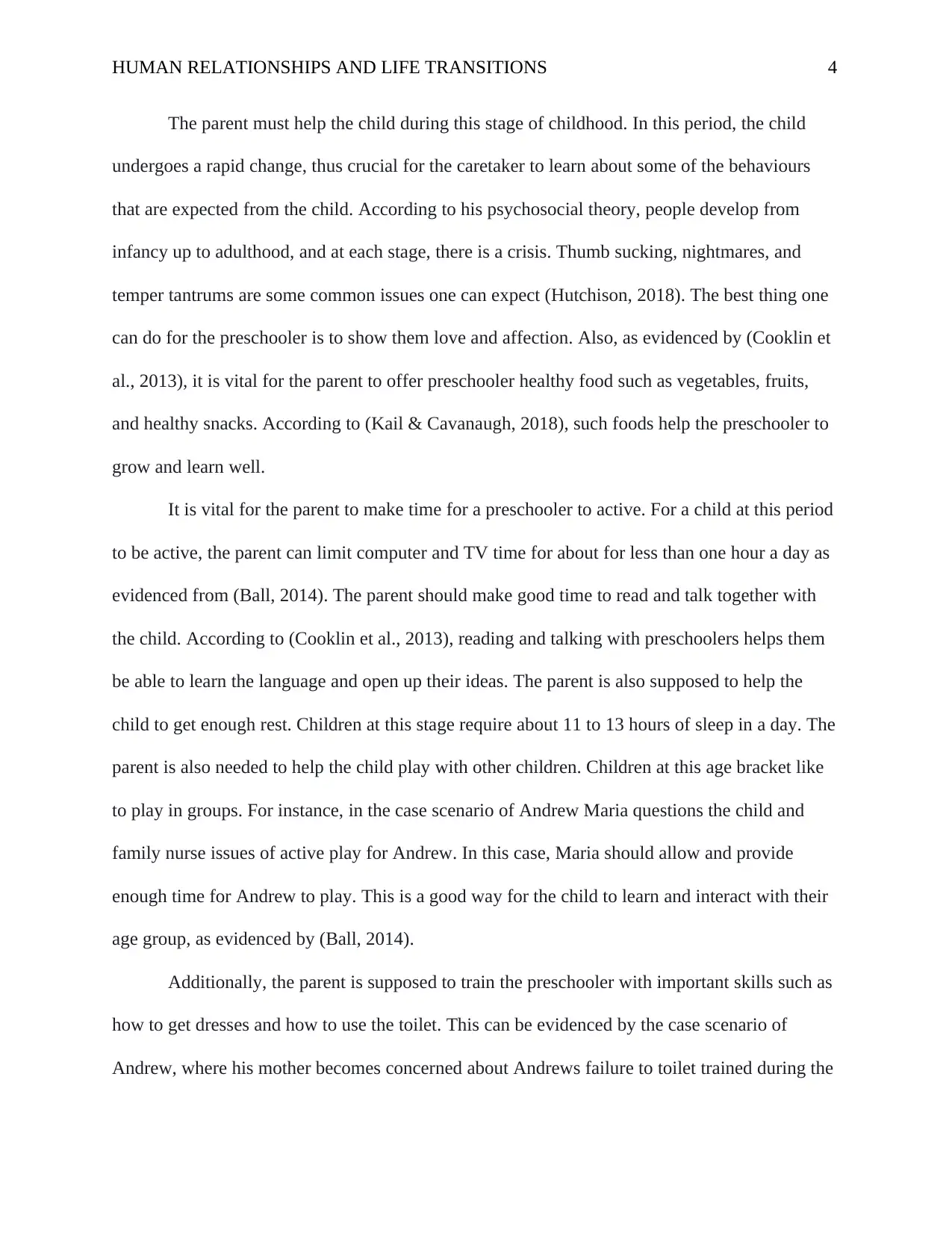
HUMAN RELATIONSHIPS AND LIFE TRANSITIONS 4
The parent must help the child during this stage of childhood. In this period, the child
undergoes a rapid change, thus crucial for the caretaker to learn about some of the behaviours
that are expected from the child. According to his psychosocial theory, people develop from
infancy up to adulthood, and at each stage, there is a crisis. Thumb sucking, nightmares, and
temper tantrums are some common issues one can expect (Hutchison, 2018). The best thing one
can do for the preschooler is to show them love and affection. Also, as evidenced by (Cooklin et
al., 2013), it is vital for the parent to offer preschooler healthy food such as vegetables, fruits,
and healthy snacks. According to (Kail & Cavanaugh, 2018), such foods help the preschooler to
grow and learn well.
It is vital for the parent to make time for a preschooler to active. For a child at this period
to be active, the parent can limit computer and TV time for about for less than one hour a day as
evidenced from (Ball, 2014). The parent should make good time to read and talk together with
the child. According to (Cooklin et al., 2013), reading and talking with preschoolers helps them
be able to learn the language and open up their ideas. The parent is also supposed to help the
child to get enough rest. Children at this stage require about 11 to 13 hours of sleep in a day. The
parent is also needed to help the child play with other children. Children at this age bracket like
to play in groups. For instance, in the case scenario of Andrew Maria questions the child and
family nurse issues of active play for Andrew. In this case, Maria should allow and provide
enough time for Andrew to play. This is a good way for the child to learn and interact with their
age group, as evidenced by (Ball, 2014).
Additionally, the parent is supposed to train the preschooler with important skills such as
how to get dresses and how to use the toilet. This can be evidenced by the case scenario of
Andrew, where his mother becomes concerned about Andrews failure to toilet trained during the
The parent must help the child during this stage of childhood. In this period, the child
undergoes a rapid change, thus crucial for the caretaker to learn about some of the behaviours
that are expected from the child. According to his psychosocial theory, people develop from
infancy up to adulthood, and at each stage, there is a crisis. Thumb sucking, nightmares, and
temper tantrums are some common issues one can expect (Hutchison, 2018). The best thing one
can do for the preschooler is to show them love and affection. Also, as evidenced by (Cooklin et
al., 2013), it is vital for the parent to offer preschooler healthy food such as vegetables, fruits,
and healthy snacks. According to (Kail & Cavanaugh, 2018), such foods help the preschooler to
grow and learn well.
It is vital for the parent to make time for a preschooler to active. For a child at this period
to be active, the parent can limit computer and TV time for about for less than one hour a day as
evidenced from (Ball, 2014). The parent should make good time to read and talk together with
the child. According to (Cooklin et al., 2013), reading and talking with preschoolers helps them
be able to learn the language and open up their ideas. The parent is also supposed to help the
child to get enough rest. Children at this stage require about 11 to 13 hours of sleep in a day. The
parent is also needed to help the child play with other children. Children at this age bracket like
to play in groups. For instance, in the case scenario of Andrew Maria questions the child and
family nurse issues of active play for Andrew. In this case, Maria should allow and provide
enough time for Andrew to play. This is a good way for the child to learn and interact with their
age group, as evidenced by (Ball, 2014).
Additionally, the parent is supposed to train the preschooler with important skills such as
how to get dresses and how to use the toilet. This can be evidenced by the case scenario of
Andrew, where his mother becomes concerned about Andrews failure to toilet trained during the
Paraphrase This Document
Need a fresh take? Get an instant paraphrase of this document with our AI Paraphraser
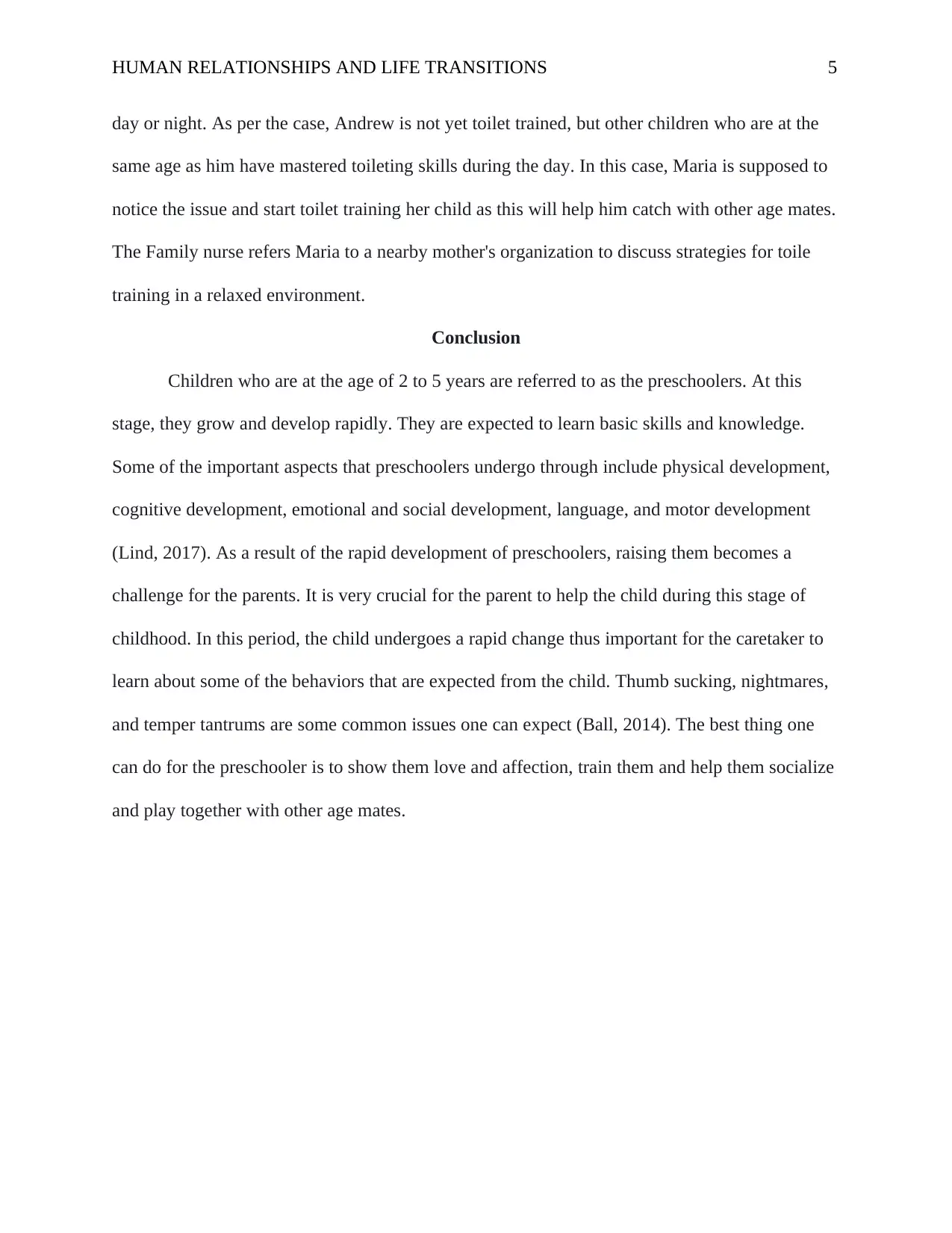
HUMAN RELATIONSHIPS AND LIFE TRANSITIONS 5
day or night. As per the case, Andrew is not yet toilet trained, but other children who are at the
same age as him have mastered toileting skills during the day. In this case, Maria is supposed to
notice the issue and start toilet training her child as this will help him catch with other age mates.
The Family nurse refers Maria to a nearby mother's organization to discuss strategies for toile
training in a relaxed environment.
Conclusion
Children who are at the age of 2 to 5 years are referred to as the preschoolers. At this
stage, they grow and develop rapidly. They are expected to learn basic skills and knowledge.
Some of the important aspects that preschoolers undergo through include physical development,
cognitive development, emotional and social development, language, and motor development
(Lind, 2017). As a result of the rapid development of preschoolers, raising them becomes a
challenge for the parents. It is very crucial for the parent to help the child during this stage of
childhood. In this period, the child undergoes a rapid change thus important for the caretaker to
learn about some of the behaviors that are expected from the child. Thumb sucking, nightmares,
and temper tantrums are some common issues one can expect (Ball, 2014). The best thing one
can do for the preschooler is to show them love and affection, train them and help them socialize
and play together with other age mates.
day or night. As per the case, Andrew is not yet toilet trained, but other children who are at the
same age as him have mastered toileting skills during the day. In this case, Maria is supposed to
notice the issue and start toilet training her child as this will help him catch with other age mates.
The Family nurse refers Maria to a nearby mother's organization to discuss strategies for toile
training in a relaxed environment.
Conclusion
Children who are at the age of 2 to 5 years are referred to as the preschoolers. At this
stage, they grow and develop rapidly. They are expected to learn basic skills and knowledge.
Some of the important aspects that preschoolers undergo through include physical development,
cognitive development, emotional and social development, language, and motor development
(Lind, 2017). As a result of the rapid development of preschoolers, raising them becomes a
challenge for the parents. It is very crucial for the parent to help the child during this stage of
childhood. In this period, the child undergoes a rapid change thus important for the caretaker to
learn about some of the behaviors that are expected from the child. Thumb sucking, nightmares,
and temper tantrums are some common issues one can expect (Ball, 2014). The best thing one
can do for the preschooler is to show them love and affection, train them and help them socialize
and play together with other age mates.
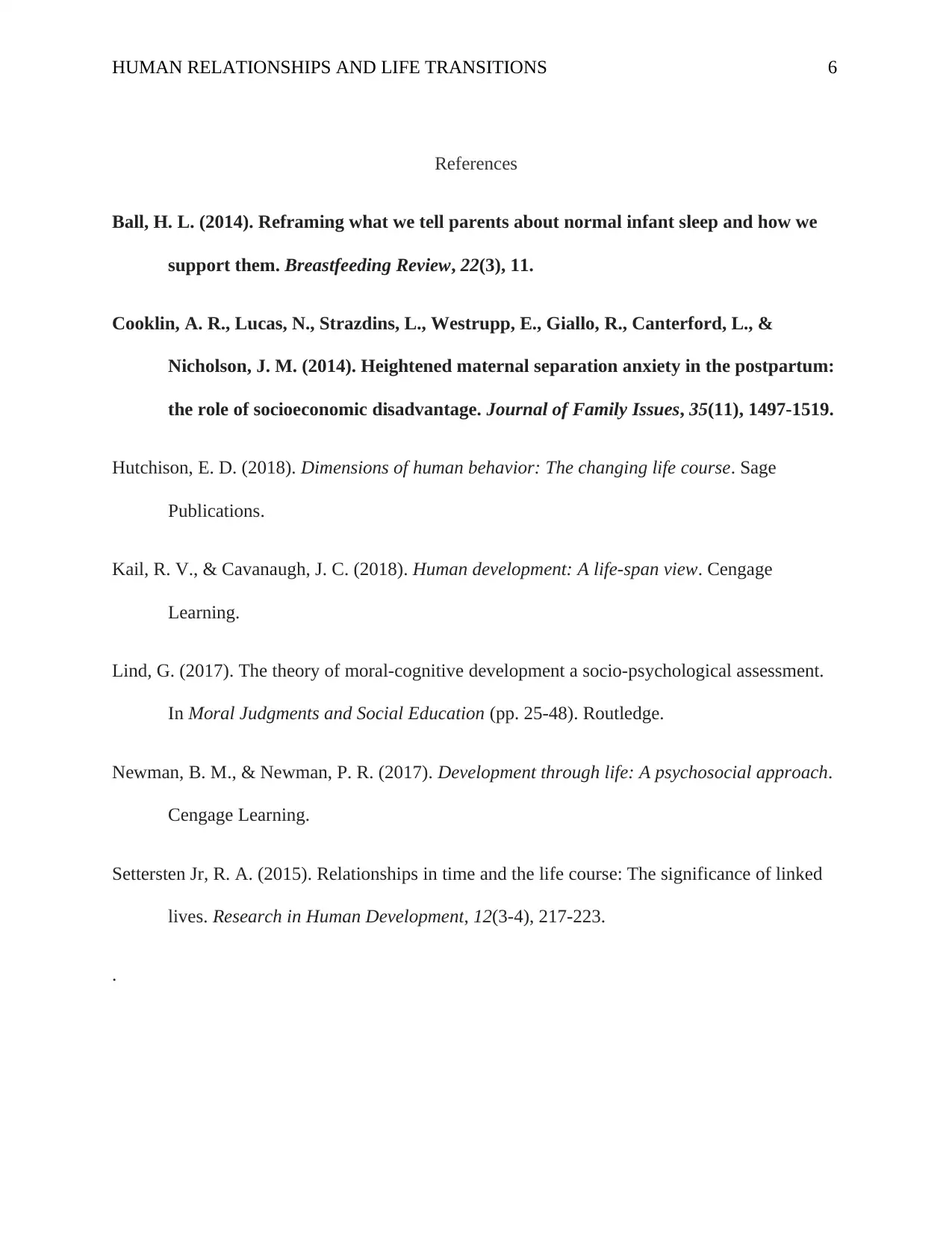
HUMAN RELATIONSHIPS AND LIFE TRANSITIONS 6
References
Ball, H. L. (2014). Reframing what we tell parents about normal infant sleep and how we
support them. Breastfeeding Review, 22(3), 11.
Cooklin, A. R., Lucas, N., Strazdins, L., Westrupp, E., Giallo, R., Canterford, L., &
Nicholson, J. M. (2014). Heightened maternal separation anxiety in the postpartum:
the role of socioeconomic disadvantage. Journal of Family Issues, 35(11), 1497-1519.
Hutchison, E. D. (2018). Dimensions of human behavior: The changing life course. Sage
Publications.
Kail, R. V., & Cavanaugh, J. C. (2018). Human development: A life-span view. Cengage
Learning.
Lind, G. (2017). The theory of moral-cognitive development a socio-psychological assessment.
In Moral Judgments and Social Education (pp. 25-48). Routledge.
Newman, B. M., & Newman, P. R. (2017). Development through life: A psychosocial approach.
Cengage Learning.
Settersten Jr, R. A. (2015). Relationships in time and the life course: The significance of linked
lives. Research in Human Development, 12(3-4), 217-223.
.
References
Ball, H. L. (2014). Reframing what we tell parents about normal infant sleep and how we
support them. Breastfeeding Review, 22(3), 11.
Cooklin, A. R., Lucas, N., Strazdins, L., Westrupp, E., Giallo, R., Canterford, L., &
Nicholson, J. M. (2014). Heightened maternal separation anxiety in the postpartum:
the role of socioeconomic disadvantage. Journal of Family Issues, 35(11), 1497-1519.
Hutchison, E. D. (2018). Dimensions of human behavior: The changing life course. Sage
Publications.
Kail, R. V., & Cavanaugh, J. C. (2018). Human development: A life-span view. Cengage
Learning.
Lind, G. (2017). The theory of moral-cognitive development a socio-psychological assessment.
In Moral Judgments and Social Education (pp. 25-48). Routledge.
Newman, B. M., & Newman, P. R. (2017). Development through life: A psychosocial approach.
Cengage Learning.
Settersten Jr, R. A. (2015). Relationships in time and the life course: The significance of linked
lives. Research in Human Development, 12(3-4), 217-223.
.
⊘ This is a preview!⊘
Do you want full access?
Subscribe today to unlock all pages.

Trusted by 1+ million students worldwide
1 out of 6
Related Documents
Your All-in-One AI-Powered Toolkit for Academic Success.
+13062052269
info@desklib.com
Available 24*7 on WhatsApp / Email
![[object Object]](/_next/static/media/star-bottom.7253800d.svg)
Unlock your academic potential
Copyright © 2020–2025 A2Z Services. All Rights Reserved. Developed and managed by ZUCOL.





